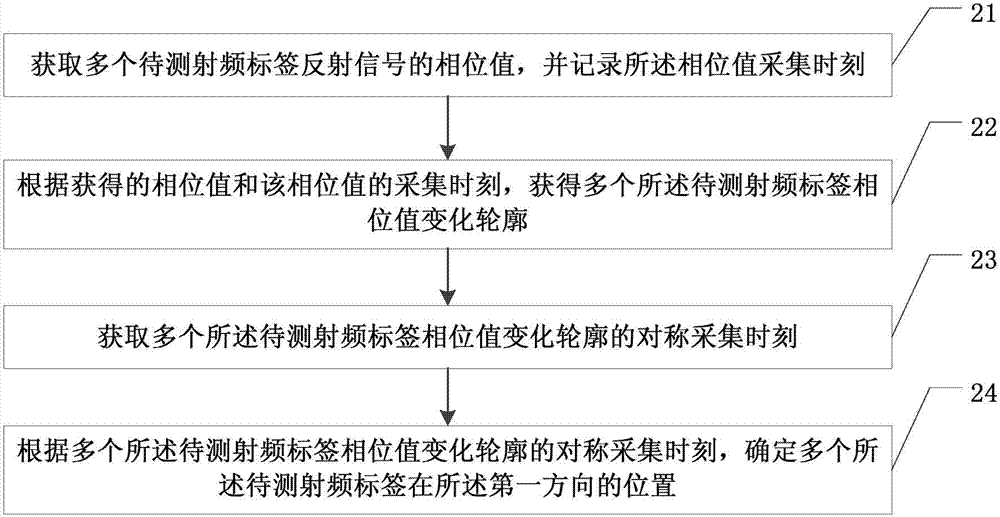Radio frequency tag positioning method and system
A technology of radio frequency tags and positioning methods, applied in the field of radio frequency identification, can solve the problems of expensive, non-promotable and universal, and achieve the effect of improving accuracy
- Summary
- Abstract
- Description
- Claims
- Application Information
AI Technical Summary
Problems solved by technology
Method used
Image
Examples
Embodiment 1
[0046] figure 1 For a flow chart of a radio frequency tag positioning method provided in Embodiment 1 of the present invention, see figure 1 , the method includes:
[0047] Step 11. Obtain phase values of reflected signals of multiple radio frequency tags to be tested, and record the acquisition time of the phase values.
[0048] Among them, a plurality of radio frequency tags to be tested are attached to the object to mark the position of the object. The radio frequency tags to be tested can receive the detection signal transmitted by the directional antenna, and after receiving the detection signal, transmit a reflected signal to the radio frequency receiver , the reflected signal carries phase information, and the phase information reflects the distance between the radio frequency tag to be tested and the directional antenna. After the radio frequency receiver extracts the phase value from the received reflected signal, it records the acquisition time of the phase value...
Embodiment 2
[0054] figure 2 It is a flow chart of a radio frequency tag positioning method provided in Embodiment 2 of the present invention. In the embodiment of the present invention, by receiving the reflected signal of the radio frequency tag, using the time-space correlation of the phase of the reflected signal to infer the positional relationship of the tag in two-dimensional space, for example, it can be applied to the sequence of books on the bookshelf and the sequence of luggage on the conveyor belt exact sorting etc.
[0055] see figure 2 , the method includes:
[0056] Step 21. Obtain the phase values of the reflected signals of multiple radio frequency tags to be tested, and record the acquisition time of the phase values.
[0057] This step is similar to the implementation process of step 11 in the first embodiment, and will not be repeated here.
[0058] Step 22: Obtain a plurality of phase value change profiles of the radio frequency tags to be tested according to t...
Embodiment 3
[0067] On the basis of the above embodiments, the embodiment of the present invention also provides a method for obtaining a plurality of phase value change profiles of the radio frequency tags to be tested, Figure 6 To obtain a flow chart of multiple phase value change profiles of the RF tag to be tested, see Figure 6 ,include:
[0068] Step 31, obtaining phase value vectors of a plurality of radio frequency tags to be tested;
[0069] For example, for a radio frequency tag P to be tested, at the acquisition time ti, the phase value of the radio frequency tag P to be tested obtained is pi, and a set of phase values within a period of time T is collected to form a phase value vector P of the radio frequency tag P1 to be tested ( p1, p2, ... pi, ... pn), wherein, the length of the phase value vector P(p1, p2, ... pi, ..., pn) of the radio frequency tag to be tested is n, and n is the number of phase value collection points of the radio frequency tag to be tested. Similarl...
PUM
 Login to View More
Login to View More Abstract
Description
Claims
Application Information
 Login to View More
Login to View More - R&D
- Intellectual Property
- Life Sciences
- Materials
- Tech Scout
- Unparalleled Data Quality
- Higher Quality Content
- 60% Fewer Hallucinations
Browse by: Latest US Patents, China's latest patents, Technical Efficacy Thesaurus, Application Domain, Technology Topic, Popular Technical Reports.
© 2025 PatSnap. All rights reserved.Legal|Privacy policy|Modern Slavery Act Transparency Statement|Sitemap|About US| Contact US: help@patsnap.com



